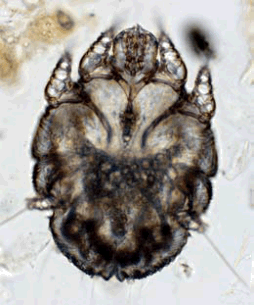| Scabies (Sarcoptic Mange) |
文京区千駄木、根津、湯島、台東区谷中、上野、西日暮里、田端、皮膚、痒い、疥癬、かいせん、犬、猫
千駄木、病院、診察、入院、子犬、子猫、谷中銀座、団子坂
疥癬、文京区、台東区、荒川区、千代田区、湯島、神田、お茶の水、動物、病院、痒み、かゆい、赤い、フケ、皮膚、皮膚、皮膚、評判
・2008年 モキシデクチンによる国内初の治療例を発表しました。
 原文: Canine Scabies 原文: Canine Scabies
ご協力:米国のUniversity of Wisconsin-Madison, Professor Moriello KA et,al.
・2013年 動物臨床医学年次大会 一般口演 犬・猫における疥癬症・毛包虫症の治療方法
ご協力:アメリカ University of Wisconsin-Madison Dr.Moriello KA
・犬猫における疥癬症・毛包虫症の治療方法 2013年11月号
ご協力:アメリカ University of Wisconsin-Madison Dr.Moriello KA
|
|
 |
| Sarcoptes Scabei |
|
|
|
|
 |
| A female Sarcoptes mite burrows in the skin and leaves a trail of eggs behind her. She generates an inflammatory response in the skin similar to an allergic response. |
|
|
Sarcoptic mange is the name for the skin disease caused by infection with the Sarcoptes scabiei mite. Mites are not insects; instead they are more closely related to spiders. They are microscopic and cannot be seen with the naked eye.
Adult Sarcoptes scabiei mites live 3 to 4 weeks in the host skin. After mating, the female burrows
into the skin, depositing 3 to 4 eggs in the tunnel behind her. The eggs
hatch in 3 to10 days, producing a larvae that in turn move about on the
skin surface, eventually molting into a nymphal stage and finally into
an adult. The adults move on the surface of the skin where they mate and
the cycle begins again with the female burrowing and laying eggs.
Appearance of the Disease
|
|
 |
| Dog with dematitis problem typical of sarcoptic mange. Many dogs do not develop the classical ear margin crusts until later in the disease. |
|
The motion of the mite in and on the skin is extremely itchy. Furthermore, burrowed mites and their eggs generate a massive allergic response in the skin that is even itchier.
Mites prefer hairless skin and thus the ear flaps, elbows and abdomen are at highest risk for the red, scaly itchy skin that characterizes sarcoptic mange. This pattern of itching is similar to that found with airborne allergies (atopy) as well as with food allergies. Frequently, before attempting to sort out allergies, a veterinarian will simply treat a patient for sarcoptic mange as a precaution. It is easy to be led down the wrong path and pursue allergy aggressively if you consider sarcoptic mange too unusual or unlikely.
As the infection progresses, eventually most of the dog's body will be involved. Classically, though, the picture begins on the ears (especially the ear margins), elbows, and abdomen.
The term Scabies refers to mite infestations by either Sarcoptes scabiei or other closely related mite species. While Sarcoptes scabiei can infect humans and cats, it tends not to persist on these hosts. When people - including some veterinarians - refer to "sarcoptic mange" or "scabies" in a cat, they are usually referring to infection by Notoedres cati, a mite closely related to Sarcoptes scabiei. In these feline cases, it would be more correct to refer to notoedric mange, though the treatment for both mites is the same. Notoedric mange in cats generally produces facial itching and scabbing.
How the Infection is Spread
Sarcoptic mange mites are usually spread by direct contact from host to host. While mites can live off of a host for days to weeks depending on their life stage, they are only infective for 36 hours, which means that environmental decontamination is generally not necessary.
Mite infections on humans are self-limiting (i.e., they go away on their own) as the mite is not able to complete its life cycle on the "wrong" host. However, the condition is extremely itchy while it lasts. The mites are most active where skin is warm, such as in bed and where clothing is snug.
If a pet affected by sarcoptic mange is in the home, it is a good idea to wash any bedding in the washing machine (or replace with new bedding), and wash any collars or harnesses.
Diagnosis
Skin Scraping � Classically, mite infection is diagnosed by scraping the skin surface
with a scalpel blade and examining the skin debris under a microscope for
mites. If the mite presence is confirmed by skin scraping, then you know
immediately the cause of the itching; you need not be concerned about allergy
possibilities or other diseases and the condition can be addressed with
confidence.
When an animal with sarcoptic mange scratches himself, he breaks open the tunnels that the mites have burrowed into and the mites are killed, although the itch persists due to toxins in the skin. The result is that the mites can be difficult to confirm by skin scraping tests. (Probably mites are confirmed in 50% or fewer of sarcoptic mange cases.)
Medication Trial - Since negative test results do not rule out mite infection, a "maybe mange" test is frequently performed. This consists simply of treating for sarcoptic mange and observing for resolution of the signs within 2 to 4 weeks. Treatment is simple and highly successful in most cases so it is fairly easy to rule out sarcoptic mange with a trial course of medication. See below for treatment options.
Biopsy - Mange mites are rarely seen on a skin biopsy sample, although if the sample is read by a pathologist who specializes in reading skin samples, the type of inflammation seen in the sample can be highly suggestive of sarcoptic mange. As a general rule, if skin is biopsied, it isa good ideafor the veterinarian to request that a dermatohistopathologist read the sample.
Treatment
While sarcoptic mange is difficult to diagnose definitively, it is fairly easy to treat and a number of choices are available.
REMEMBER, ALL DOGS IN A HOUSEHOLD WHERE SARCOPTIC MANGE HAS BEEN DIAGNOSED SHOULD BE TREATED.
Ivermectin - This is one of the most effective treatments against Sarcoptes scabiei yet it is off-label as far as the FDA is concerned. There are several protocols because of the long activity of this drug in the body. Typically an injection is given either weekly or every two weeks in one to four doses.
In most cases this treatment is safe and effective but some individuals
have a mutation that makes ivermectin toxic at the doses used to kill mites.
These individuals are usuallyin the Collie family: Collies, Shetland Sheepdogs,
and Australian Shepherds are classically affected. There is now a test
that can determine if any dog has the mutation that makes ivermectin use
dangerous. An additional caution comes from an interaction with the relatively
new flea control product Comfortisョ (spinosad). Relatively high doses of
ivermectin are needed to treat sarcoptic mange and if Comfortisョ is used
concurrently, ivermectin side effects are more likely to occur. While ivermectin
is a prototype compound upon which most other sarcoptic mange treatments
are based, it may be worth using a product that has actually been approved
for the treatment of sarcoptic mange.
Selamectin (Revolutionョ) - Selamectin is an ivermectin derivative recently marketed for dogs
for the control of fleas, ticks, heartworm, ear mites, and sarcoptic mange
mites. Normal monthly use of this product should prevent a sarcoptic mange
problem but studies show that to clear an infection, for reliable results
an extra dose is usually needed after 2 weeks. This product is probably
the best choice for Collie or Australian shepherd breeds.
See more information from the manufacturer on Revolution.
Moxidectin (Advantage Multiョ) � Moxidectin is yet another ivermectin derivative. In Advantage Multi,
it is combined with imidacloprid, a flea-killing topical, to create a product
used against heartworm, hookworm, roundworm, whipworm, and fleas. In the
U.S. this product is not FDA labeled for sarcoptic mange but it is in other
countries and should still be effective even though technically it is off-label.
See more information from the manufacturer on Advantage Multi
Milbemycin Oxime (Interceptorョ or Sentinelョ) - Milbemycin oxime is approved for heartworm prevention as a monthly oral treatment (as either Interceptorョ or Sentinelョ). Happily, it also has activity against sarcoptic mange and several protocols have been recommended by different dermatologists. This is another medication thatyou might find recommended.
See more information on Interceptorfrom the manufacturer,and seetheir
page for Sentinel.
Dipping - Anti-bacterial or anti-itch shampoos precede one of several anti-mite dips. Mitaban dips (Amitraz) or lime-sulfur dips given weekly are usually effective. Disease typically resolves within one month. Dipping is labor intensive and rarely done any more as the other products are easier and more rapidly effective. We mention dipping since it has been a standard mange treatment for decades prior to the introduction of ivermectin.
*Quoation from VIN
|

